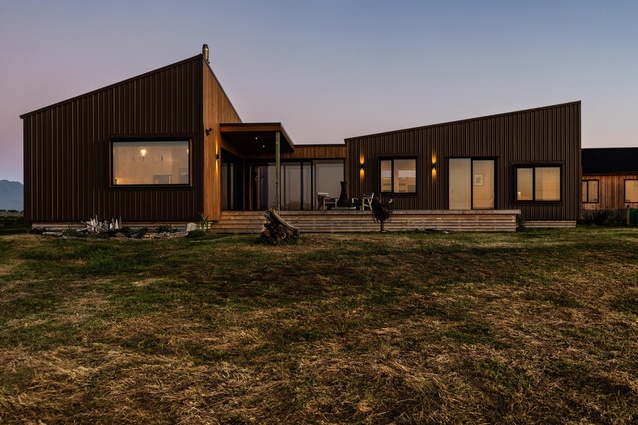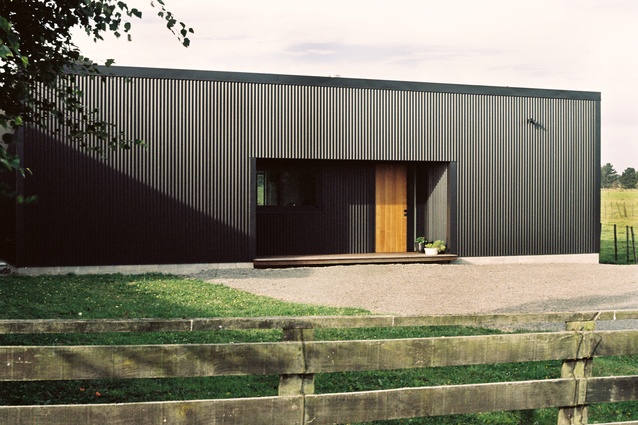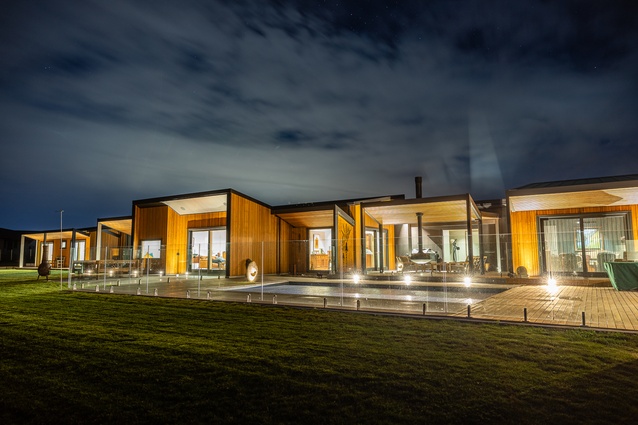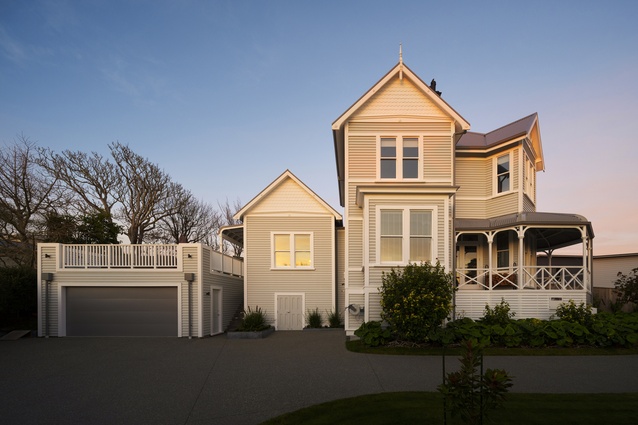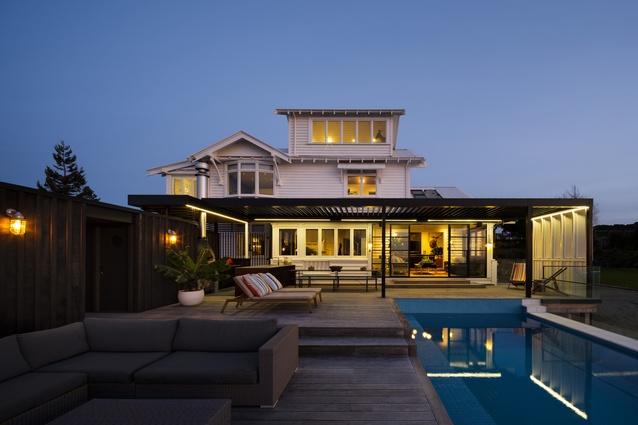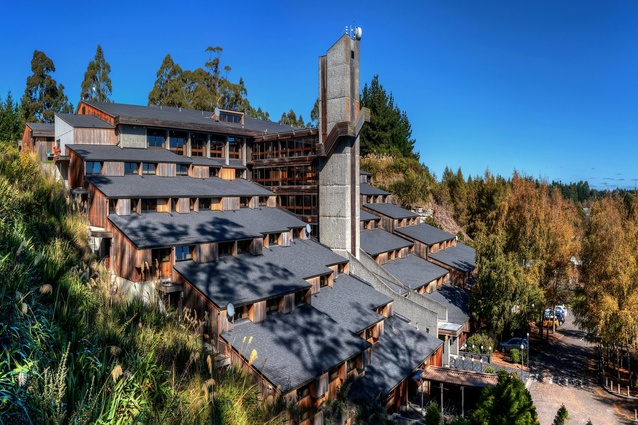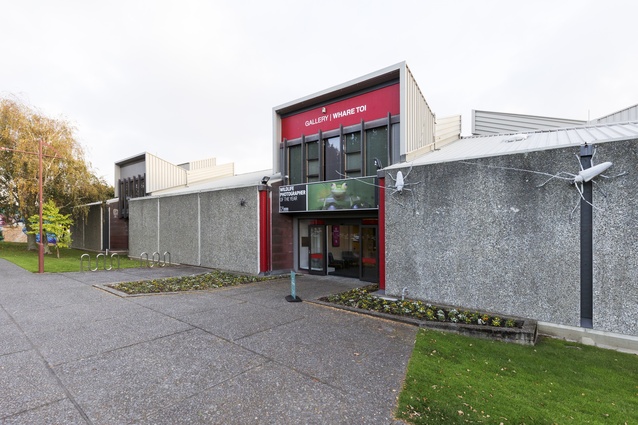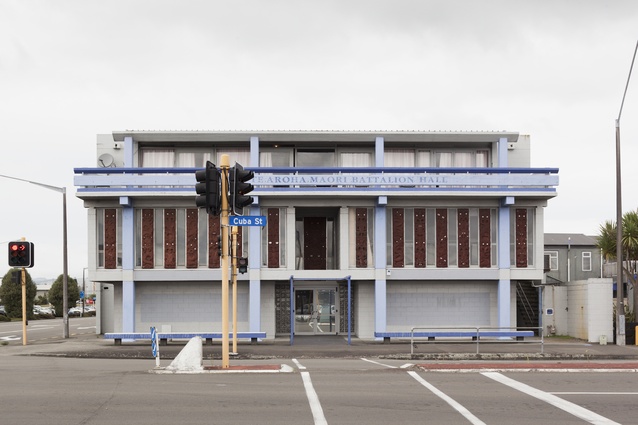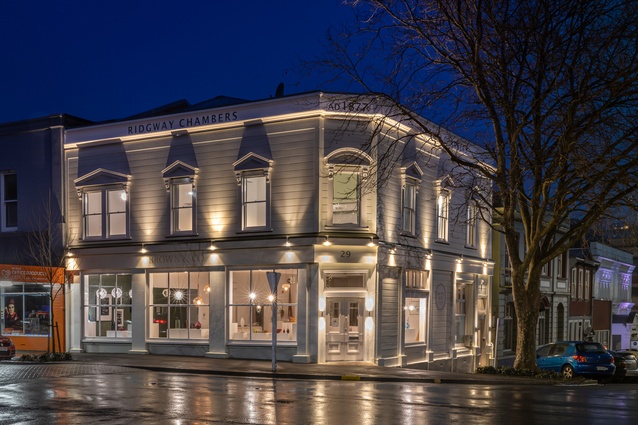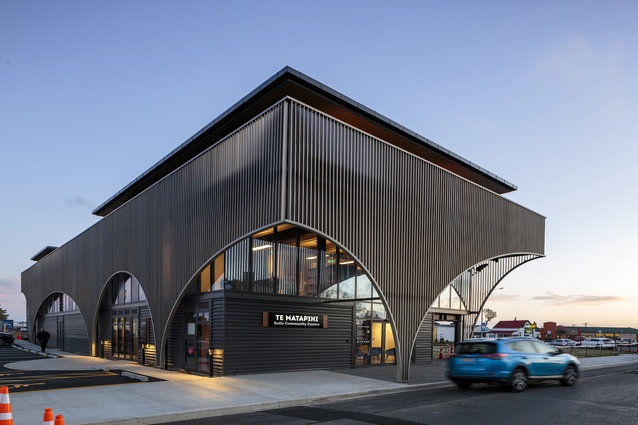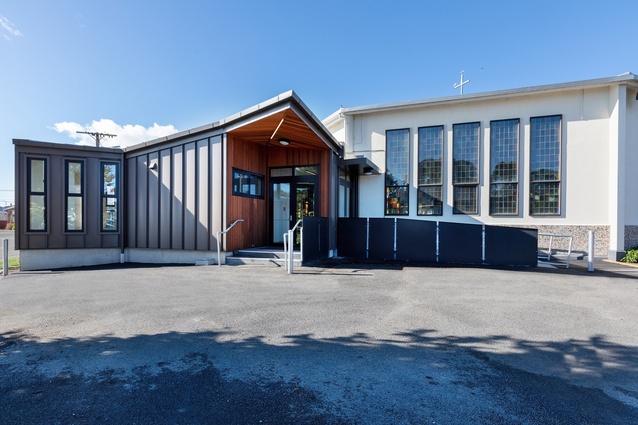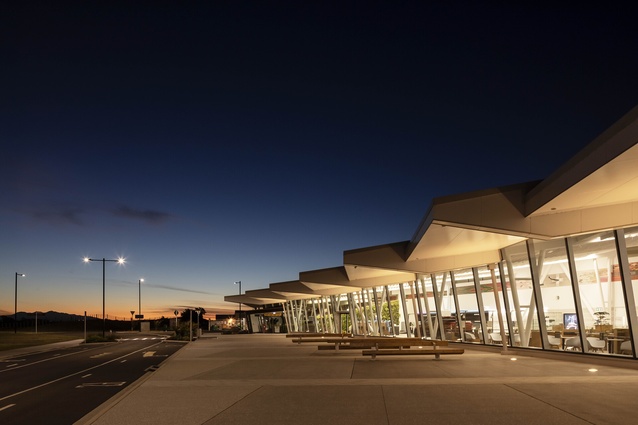Winners revealed: 2021 Western Architecture Awards
As part of its peer-reviewed Local Awards programme, the Te Kāhui Whaihanga New Zealand Institute of Architects (NZIA) Local Awards has announced the winners for the Western region, which includes Taranaki, Whanganui and Manawatu.
Held at New Plymouth’s Len Lye Centre, the ceremony was adjudicated by convener Darren Shadbolt of Architype Team Architects, along with Ewan Brown of Tennent Brown Architects, Michael Russo of BSM Group Architects and Stacey Cleland, an architectural graduate with Design Group Stapleton Elliott. Among the winners were three buildings older than 25 years, each of which received an Enduring Architecture award after being judged to have stood the test of time.
See the full line-up of winners below with jury citations.
Housing
Twigley Bach by Boon
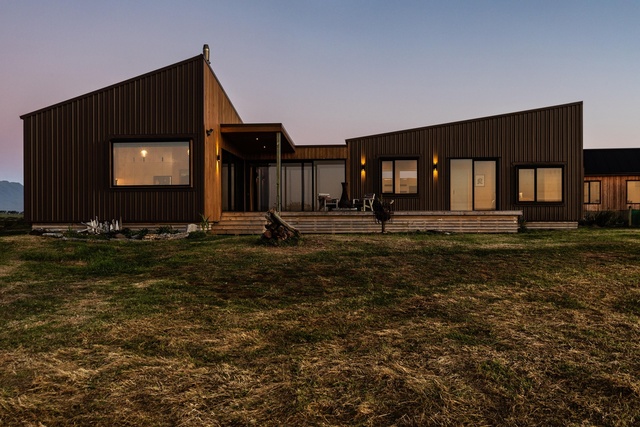
This cleverly designed beachside bach demonstrates a skilful response to its surrounding landscape. Glazing acknowledges the passage of the sun and provides numerous visual connections to ocean and mountain, while the home’s robust structure and appropriately chosen materials mean Twigley Bach offers both a place of refuge from, and celebration of, the coastal weather. Further, the building’s ability to be relocated responds innovatively to planning requirements and future sea level challenges. Through clever spatial planning, the architect has provided ample space internally, overcoming challenging restrictions on building size and construction. A voluminous living space serves as a family hub, while adjacent bunk spaces readily transform to accommodate visiting friends and family. Elements of bespoke craftsmanship and considered design are evident in the built-in joinery, which contributes to the overall high-quality finish.
M + M House by Boon

M + M House conforms to the extremes of its exposed coastal site in Warea, Taranaki. With larch exterior cladding, pile foundations, and a subtly contorted gable form, it responds to the conditions of its landscape through texture, durability, colour and shelter, and is also transportable. In response to an extensive brief, the home provides incredible amenity within a small footprint. It could be considered as two separate, small dwellings connected by a protected deck, which captures expansive views of both Mt Taranaki and the rugged coastline on which it sits. A surprising composition of quirky, fun elements throughout the house’s interior is combined with serene, earthy, and elegant details to make M + M House an enticing place to dwell.
Small Town House by Felicity Wallace Architects
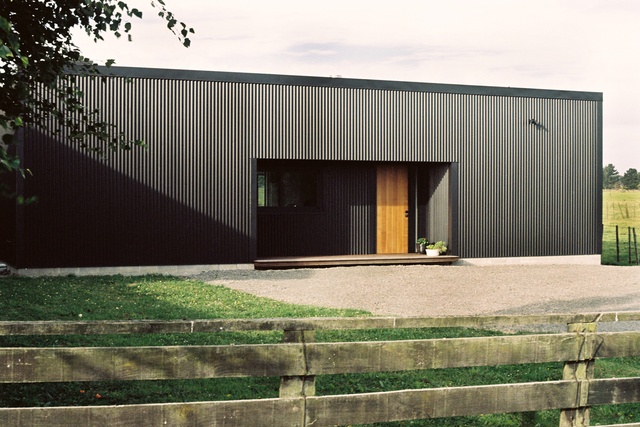
This small town house celebrates architecture that is affordable and considered. Sited at the edge of a small, rural and once industrial street, the home has a strong presence in the neighbourhood. It respects the scale and setback of adjacent dwellings, while presenting a fresh elevation in its simple black corrugate and timber form. Inside, the kitchen, hall and entry deck are places of sharing and exchange, offering views to both the street and the rural landscape. Authentic materials and construction methods are celebrated in this home, making it a versatile and successful space for those who live there.
Stewart Residence by 242am Architects

A close and thoughtful collaboration between client and architect, this energy-efficient passive house is an easy and comfortable place to live and entertain in, and is carefully designed to create a delightful duality. Upon approach, one is greeted by an entranceway that will scoop you up and draw you through the solid boundary wall, beyond which a series of internal and external rooms are strung along an internal spine. The sun and wind are cleverly softened and managed by external frames, while views to the north gather around an outdoor pool.
Resene Colour Award
This house embraces pattern, material and colour to provide a rich experience. Each room has been considered, with colour, surface and texture capturing the essence of each space. The powder room is a particular delight.
Housing – Alterations and Additions
Whareora by Gibbons Architects
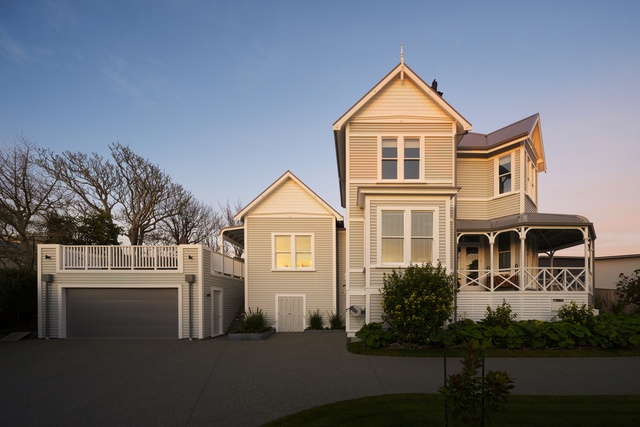
Whareora represents a significant restoration and a sympathetic addition to an existing home with a long history of alterations. A single-storey wing with attached garage and outdoor entertaining area to the south has been expertly designed to enhance the existing building and make efficient use of the site. Care has been taken in the selective removal of internal walls to create visual links between spaces and to introduce light into the interior. Materials and colour choices are thoughtfully composed, bringing a freshness to rooms, while playful detailing in the re-creation of balusters and panelling links new and existing elements. The gentle modernisation of existing spaces and the addition of a new kitchen has improved the function of each space and preserved the home for years to come.
Pendarves by Gibbons Architects

A well-considered and crafted response to the client’s brief, the Pendarves Street house, originally constructed in the 1920s with alterations since, has been fine-tuned into a functional, modern home. A light-filled central staircase and several small, visual connections between spaces are evidence of considered interventions which have enhanced the original building. The architect has demonstrated exceptional collaboration with the client, producing a home tailored to a unique style and aesthetic. Attention to colour and richness of textures, coupled with innovative use of materials - both inside and out - has resulted in a home that is a delight to inhabit.
Resene Colour Award
The architects have worked closely with their clients to use complementary colours, materials and textures to suit their eclectic furniture and treasures. The result is surprising and captivating.
Education
Te Ohu Rangahau Kai – Joint Food Science Facility by Warren and Mahoney Architects and Lab-works Architecture in association

This project has been a journey of collaboration between three client organisations; AgResearch, Massey University and the Riddet Institute. It was facilitated by two architects who managed the intricate complexity of a building that sits between the worlds of research and education. A diagram in efficiency, Te Ohu Rangahau Kai is surrounded by an external veil of impossibly long and slender posts that lift the simple form beyond the functional. Sitting amid the leafy Massey campus and with extensive natural views, this innovative building will service the generation of research and development for many years to come.
Resene Colour Award
A careful and restrained palette of subtle colors and pattern throughout work together in harmony to reinforce a comfortable and calm work environment.
Enduring Architecture
New Zealand Defence Force Waiouru – Officers Barracks & Mess (1984) by Belchambers, Low & Associates
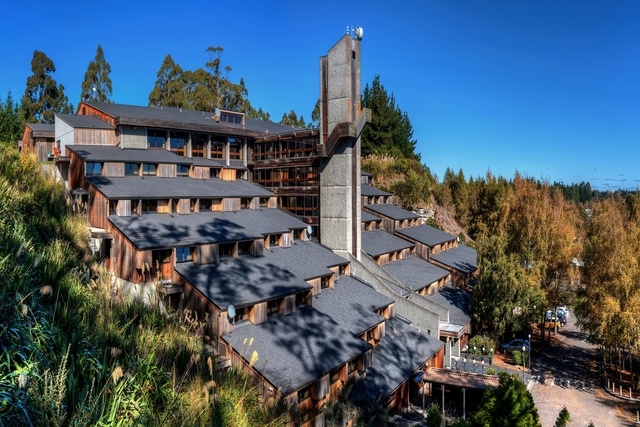
While hidden from public view for 36 years, those fortunate enough to have visited the Waiouru Officers Barracks and Mess Hall will know the building exudes both great mana and an understated sense of ceremony. Its enduring quality is a direct result of design decisions that its architect, Eddie Belchambers, made in collaboration with the Ministry of Works and Payne Sewell & Partners Engineers. The barracks were deployed as six north-facing terraces that step up the dramatic sloping site, hugging its contours. Internally, cranked corridors break the mass of the building into a highly coherent pattern of roofs and walls. Capped by the mess hall and bars, the barracks are a rare example of an eight-storey building with seven ground floors, organised around a central lift tower that rises like a concrete stack into the Waiouru sky. Reinforced concrete in a variety of finishes is softened by cedar cladding, trimmed with copper spouting, and blended into the landscape by the organic layout of terraces in varying lengths. The architect deftly steered his design away from the Brutalism that was common at the time and instead created a highly memorable legacy – an alpine wharenui with a rugged organic flavour that marries a rigorous government brief with a thoughtful design.
Te Manawa Te Papaioea (1977) by David Taylor – Architect

Heralded as a new direction for the art scene in the Manawatu, and indeed the rest of the country, the Manawatu Art Gallery embraced the latest modernist ideas, and used textured and cast in situ concrete, metal and timber in a new way. The existing building is stage one of a larger, unrealised development. Clerestory windows, skillion roofs and a central mezzanine floor provide a variety of exhibition spaces, viewing points and office accommodation. The building is inwardly focused yet retains views and connections to the landscaped exterior, while admitting natural light into gallery spaces. The building was, and continues to be, a worthy sanctuary for important works of art, and is itself a taonga that the city can be grateful for.
Te Rau O Te Aroha – Māori Battalion Hall (1964) by John Scott – Architect
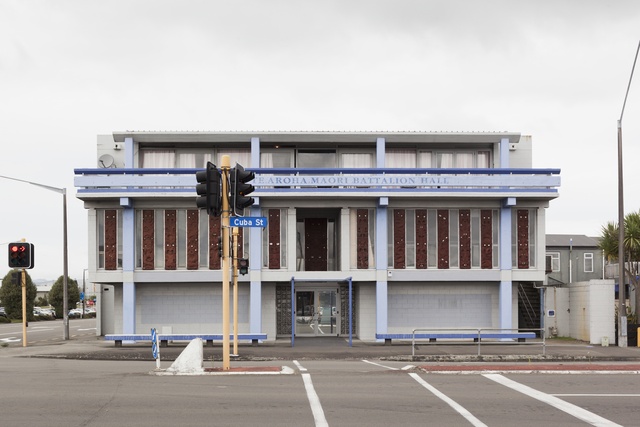
The Māori Battalion Hall, Te Rau O Te Aroha, was erected in Palmerston North on Cuba St as a national memorial to the men of the 28th Māori Battalion who lost their lives in the Second World War. Largely funded by local Māori under the Raukawa Tribal Executive, it was designed by John Scott, architect of Te Arawa from Haumoana, Hawke’s Bay. During a period obsessed with the social and political issues separating Māori and Pākehā, Scott envisaged fusion, rather than division. Te Rau o te Aroha incorporates elements of both te ao Māori and te ao Pākehā, with 14 carved panels on the façade by Kelly Kereama. Inside, 639 names of those who did not return are inscribed on 14 brass plates. The concrete construction, both inside and out, was left unplastered, with the marks of the boxing left to symbolise the strength of the Māori people.
Heritage
Ridgway Chambers by Drawing Room Architecture & Design
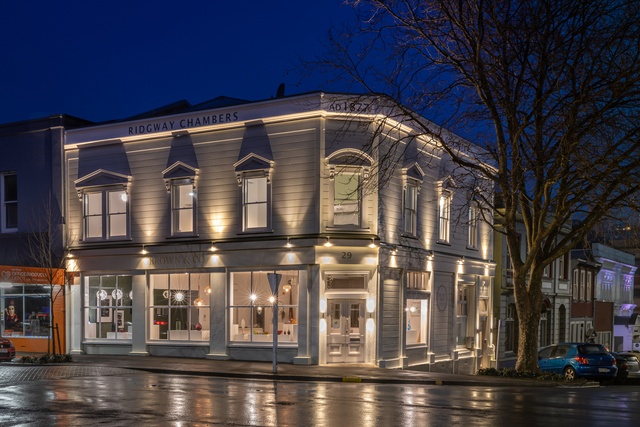
Situated on Whanganui’s most picturesque street, in an area earmarked for future urban regeneration, Ridgway Chambers contributes to the reactivation of neighbouring areas by promoting central city living and providing an active street frontage. The heritage value of the building has been enhanced through careful emulation of the original façade, while a crisp, open gallery space displays its treasures to the street, further enhancing the urban scene. Upper floor apartments make efficient use of space through careful arrangement of activities, innovative sleeping lofts capitalise on high ceilings, and living areas afford views of adjacent green spaces. By reimagining the role of Whanganui’s oldest commercial building, the Ridgway Chambers project has retained the space for future generations.
Hospitality
Airspresso by Gibbons Architects
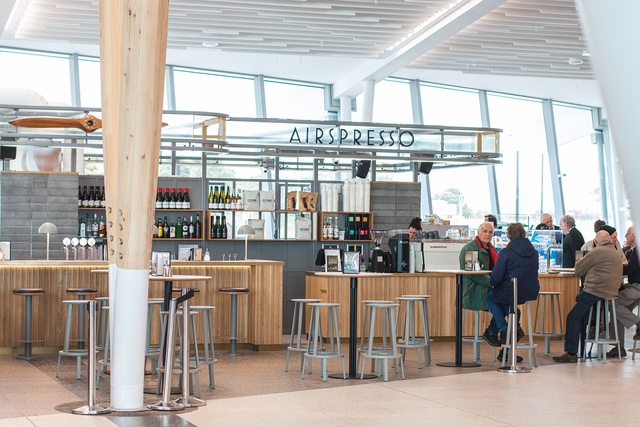
The stepping-off and landing point for coffee at the New Plymouth airport, Airspresso cafe sits comfortably amid the airport building’s muscular columns and beneath its cloud-like ceiling. This cafe confidently expresses itself, creating a moment of rest amid the tension of travel. Customer seating pinwheels from a central and efficient island workspace, and the cafe’s combination of displays and local historical information makes this a thoughtful and engaging space to inhabit, even if only in transit.
Interior Architecture
Mahi Tahi by Boon
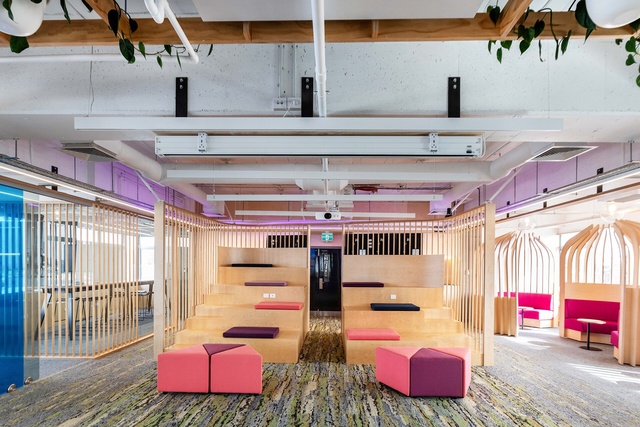
This vibrant and engaging space has transformed an ageing corporate interior into one that encourages a culture of connection, growth, and collaboration. The open office layout is carefully curated, with specialised ‘focus zones’ throughout; these areas successfully divide the space using colour and materiality, while maintaining a sense of transparency. The abundance of indoor plants and natural materials including timber, New Zealand wool and natural rubber, as well as glass to admit natural light, stimulates a sense of productivity and celebrates wellbeing.
Resene Colour Award
Colour is used extensively in this project to define space, circulation and function. This is a place to work in and enjoy.
Public Architecture
Te Matapihi – Bulls Community Centre by Architecture Workshop
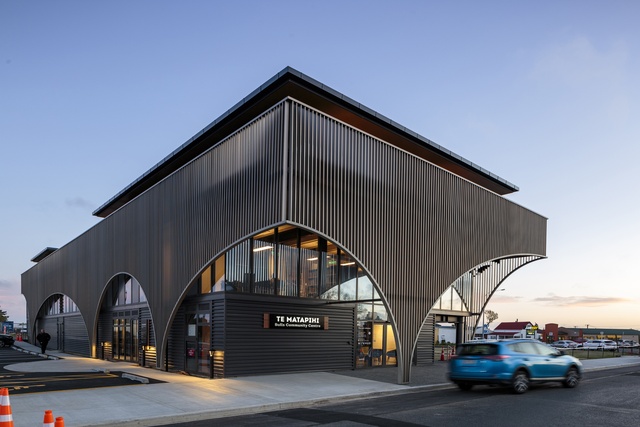
This confident public community centre presides over the small and busy town of Bulls, and fulfills a key project aspiration: to create a community centre located around a soon-to be developed adjacent urban space. As well as housing most of the district council, the generous space is home to a new library, information centre, public ablutions and a 300-seat auditorium, while a striking rooftop deck offers views across the town. Wrapped in a screen that elevates the building’s exterior and references local river terraces and a bridge, Te Matapihi signifies the beginning of a new civic centre for Bulls.
Resene Colour Award
The architect has used bold colours to surprise, highlight and adorn. A blue steel staircase dominates the entry and, together with fixtures and furnishings, provides a playful and welcoming community place.
Our Lady Help Of Christians Church Foyer by Ardern Peters Architects
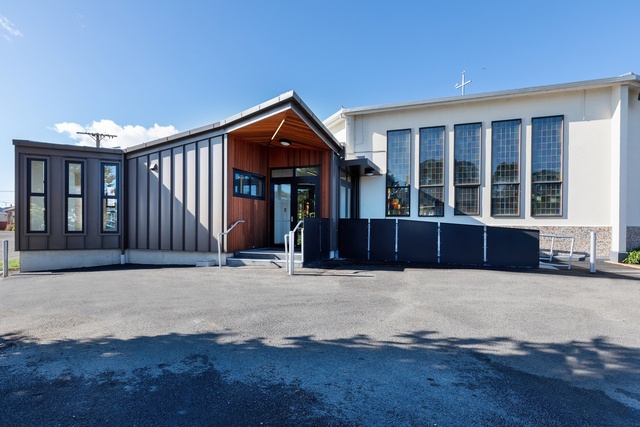
This beautifully crafted addition to an existing church creates a profound focal point at the end of the street. Combining strong symmetry with a gently composed roof form, this is a church that is both welcoming and monumental. The foyer’s glazed frontage, with its stained-glass panels, creates a vibrant transparency at the street edge, inviting visual and physical connections with the community. Its predominantly timber and metal palette creates a warm and robust environment that complements the existing building and responds to the functionality of its spaces. Though small in footprint, this work provides great amenity, and a strong sense of identity for both the building and its community.
Te Hono – New Plymouth Airport Terminal by Beca Architects

Te Hono provides an elegant gateway to the Taranaki whenua. The celestial and terrestrial narrative of the embrace of Tamarau (descending from the sky) and Rono-ue-roa (ascending from the earth) generates a powerful geometry and architectural language that runs throughout the terminal. The partnership of the client and design team with mana whenua has driven the creation of this unique building, which begins a process of healing, and addresses a need to right wrongs that were committed on this land. Opening towards an apron to the north east, the structure successfully integrates all of the technical functions of an airport terminal, while its soaring, cloudlike ceiling, extensive carvings and artworks tell the story of the land it inhabits.
Resene Colour Award
The architect has worked in collaboration with mana whenua to tell the stories of their people using colour, material and pattern. The narrative is captured as a visual progression along the spine of the building, acknowledging the place and its people.
The NZIA Local Awards 2021 programme is supported by Resene and APL.

